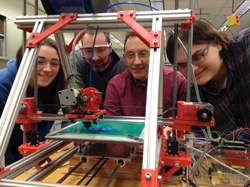“3D printing is going to be pervasive in the future, and I want to be able to say I was involved from the first,” says sophomore Christine M. Cunningham ’15, a likely computer science major. As one of the team of 10 students that worked with design engineer and model maker Michael Taylor and computer science professor Morgan McGuire to build a 3D printer during Winter Study, Cunningham has reason to be proud.

3D printing, also known as desktop fabrication, is being used to produce components in a variety of industries from the medical industry to toy manufacturers. Somewhat like a dot-matrix printer, the head of this machine moves across a flat glass surface, spelling out its final product in blue plastic—not onto paper but through a thin tube of plastic attached to the top in a large spool. One of the students unwinds it little by little, allowing the machine to have a continuous supply. The hot head of the machine feeds the melted plastic into a shape determined by the electronic file the printer reads from a nearby laptop.
As the head moves back and forth along the square glass plate, the first layer of blue plastic is laid down in the shape of an airplane, line by line, slowly moving back and forth, up and down, and around the glass. The second layer’s applied as the head raises itself a fraction of a millimeter. And on it goes, moving vertically up with each layer, along what the students call the Z-axis, at a rate nearly imperceptible to the eye.
The students built this printer from directions they cobbled together through open-source materials. People all over the world who are building 3D printers contribute their stories, measurements, and instructions to various websites: think Wikipedia for DIY computer engineers. With no clear set of instructions or a ready-made kit, the students figured out what materials they would need, and how to put them together, through a lot of trial and error.
The team recognizes that their printer’s a work in progress, maintaining that the glass surface is not perfectly flat and that the temperature the heads heats the plastic is not as precise as they would like. But the printer impressively gets the job done. After about 15 minutes, there exists something that, moments before, was a spool of plastic tubing: a small blue airplane.
Their biggest goal, says team member Daniel Seidita ’16, is “to create the college’s first usable 3D printer, and to use that to create some of the parts necessary to build another 3D printer.” To that end, the team is proudly contributing their printer to the computer science workshop, so Williams students can continue to improve—and use—the printer into the future.
Megamenu Social